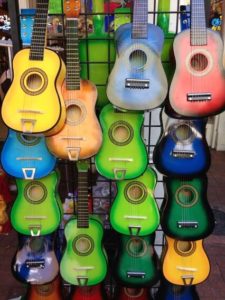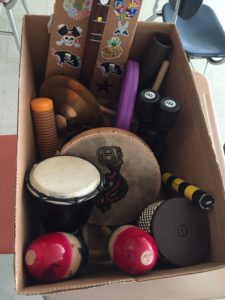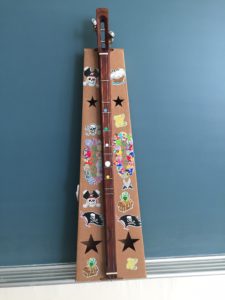 Last week, I used music twice in my high school English class. The first time was for a lesson on parallelism. After explaining the concept and having students look at historical examples, I played snippets of songs for them. They had to listen to the songs, and identify and explain the parallelism. I used a playlist I had devised a few years ago for this purpose; it includes “Birthday” by The Beatles, “You Can’t Always Get What You Want” by The Rolling Stones, “Uprising” by Muse, “Mr. Brightside” by The Killers, “Bad Romance” by Lady Gaga, and “Hot N Cold” by Katy Perry. Every year, I ask myself if this easy activity is worth the class time, or if the time could be better spent close reading or breaking down difficult words into their roots. But every year, I write a note to myself to do the lesson again the following year. The students love it. They can’t believe it’s happening. They are astounded that I have songs from Muse and The Killers. Some dance in their seats by the time Katy Perry rolls around. One student said
Last week, I used music twice in my high school English class. The first time was for a lesson on parallelism. After explaining the concept and having students look at historical examples, I played snippets of songs for them. They had to listen to the songs, and identify and explain the parallelism. I used a playlist I had devised a few years ago for this purpose; it includes “Birthday” by The Beatles, “You Can’t Always Get What You Want” by The Rolling Stones, “Uprising” by Muse, “Mr. Brightside” by The Killers, “Bad Romance” by Lady Gaga, and “Hot N Cold” by Katy Perry. Every year, I ask myself if this easy activity is worth the class time, or if the time could be better spent close reading or breaking down difficult words into their roots. But every year, I write a note to myself to do the lesson again the following year. The students love it. They can’t believe it’s happening. They are astounded that I have songs from Muse and The Killers. Some dance in their seats by the time Katy Perry rolls around. One student said  on the way out of class, “Ms. Pryle, this was the best class yet.” That makes me sad, and it makes me think: How could something so small make them so happy? Are they just suffering through every other class out of politeness? On all the other, non-musical days, we often do fun things like act out scenes or rewrite the text as Tweets. We laugh. We joke around. They seem to be learning. But listening to Lady Gaga was “the best class yet”??
on the way out of class, “Ms. Pryle, this was the best class yet.” That makes me sad, and it makes me think: How could something so small make them so happy? Are they just suffering through every other class out of politeness? On all the other, non-musical days, we often do fun things like act out scenes or rewrite the text as Tweets. We laugh. We joke around. They seem to be learning. But listening to Lady Gaga was “the best class yet”??
I think the answer goes deeper than just taking a break from the text or hearing words from this century (my class is World Literature; this week’s texts are from 1500 BCE). As we all know, music is the quickest way to generate feeling within us; it’s hard to name anything else that works faster or more effectively to this end. It’s ingrained in our DNA. This seems especially true for teens—for many of them, it’s the first thing they grab for when school ends, and the last thing they let go of when school begins.
 The second activity this week came a few days later, when we looked at some ancient poetry, which, by definition, was originally set to music. After close-reading, annotating, analyzing, questioning, and responding, I pulled out a box of kiddie music instruments from my closet. I had saved them over the years from my own sons’ baby music classes, and I add to the box when I can—it now brims with brightly colored egg shakers, tambourines, mini-bongo drums, small souvenir Liberty Bells, xylophones, triangles, a couple guiro, a cardboard dulcimer, and even a cabasa. I told the class they would be releasing the poems back to their original format, and that they could do it in any way they chose.
The second activity this week came a few days later, when we looked at some ancient poetry, which, by definition, was originally set to music. After close-reading, annotating, analyzing, questioning, and responding, I pulled out a box of kiddie music instruments from my closet. I had saved them over the years from my own sons’ baby music classes, and I add to the box when I can—it now brims with brightly colored egg shakers, tambourines, mini-bongo drums, small souvenir Liberty Bells, xylophones, triangles, a couple guiro, a cardboard dulcimer, and even a cabasa. I told the class they would be releasing the poems back to their original format, and that they could do it in any way they chose.
The students—16-year-old sophomores—could hardly contain themselves, and rushed the box to see what they could get. In groups, they performed the poems in songs, raps, chants, and choral renderings. It was hilarious and beautiful.
In all cultures, in all eras, music sends the message: It is our turn to be alive.  Whether joyful or heartbreaking or nostalgic, music is our utterance in the void. This is why we do it. We don’t need to sing to communicate; we can just as easily speak to convey our feelings. But singing goes far beyond practicality.
Whether joyful or heartbreaking or nostalgic, music is our utterance in the void. This is why we do it. We don’t need to sing to communicate; we can just as easily speak to convey our feelings. But singing goes far beyond practicality.
Is reciting an ancient poem as a rap while your friends bang sticks and maracas beside you going to help you on the state assessments? Probably not. But that day the students experienced more than any test could hope to achieve: They felt the joy of words and literature, and the primordial delight of rhythm and sound, something we usually make them turn off during school hours.

That was awesome! Love the way you incorporate music in your classes…and VERY well done! Bravo! You can borrow more instruments if you like! I still have lots:)